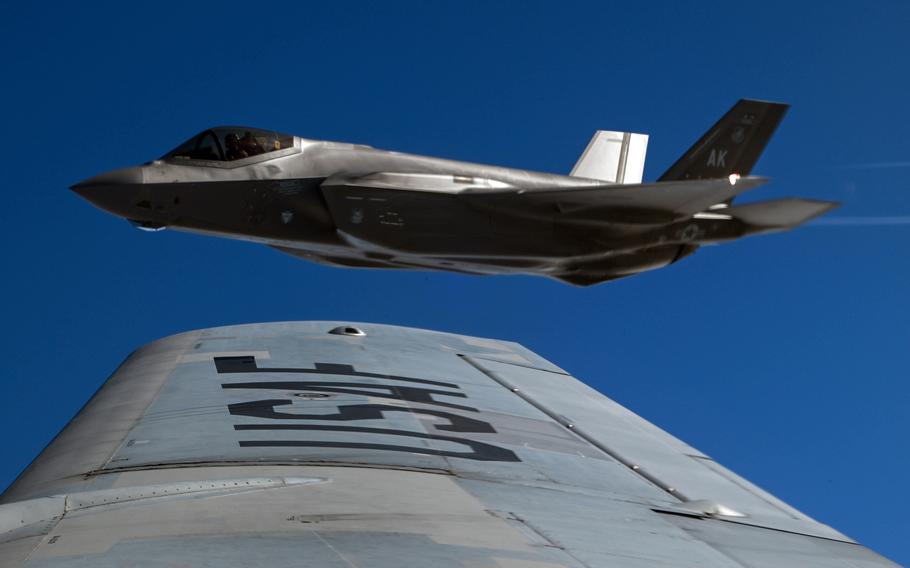
An F-35A Lightning II assigned to the 355th Fighter Squadron flies in formation after receiving fuel from a KC-135 Stratotanker near Eielson Air Force Base, Alaska, Aug. 22, 2025. (Spencer Hanson/U.S. Air Force)
Ice contamination in landing gear struts created a cascading series of events that ended with an F-35A Lightning II crashing at an air base in Alaska in January, according to an Air Force accident investigation released Monday.
The multirole stealth fighter crashed at 12:49 p.m. Jan. 28 at Eielson Air Force Base after more than an hour of airborne troubleshooting by the pilot and ground support, the report said.
The F-35A, assigned to the 355th Fighter Squadron, 354th Fighter Wing, was destroyed — a $196.5 million loss. The pilot ejected but suffered a middle-spine compression fracture and neck and face abrasions, according to the report.
The accident investigation board found that ice formed in hydraulic fluid that was contaminated with water in the nose and main landing gear struts, preventing the struts from fully extending. That, in turn, caused “weight on wheels” sensors to tell the aircraft it was on the ground, not in mid-air, according to the report.
As a result, the high-tech fighter switched to ground mode. “However, because it was actually airborne, the [mishap aircraft] was uncontrollable,” the report said.
The pilot held a 50-minute conference call with the Eielson supervisor of flying and engineers and the aircraft’s manufacturer, Lockheed Martin, before losing control of the plane, according to the report signed July 9 by Air Force Col. Michael Lewis, president of the accident investigation board.
The fighter was put through “slightly extended ground operations at extreme cold temperatures” prior to flight, according to the report. The temperature at the time of the crash was 1.4 degrees Fahrenheit.
The water in the nose landing gear strut froze first, “which started the cascading events,” Lewis wrote.
The aircraft took off as part of a four-ship training sortie of F-35As at 11:22 a.m. Another pilot, called the “mishap wingman” in the report, notified the aircraft’s pilot that his nose landing gear door was ajar.
When the pilot extended the landing gear, the wingman reported the wheel had turned 17 degrees to the left. During the conference call, Lockheed Martin, the flight supervisor and pilot agreed to try two touch-and-go landings to realign the wheel.
During the first landing, the right rear landing gear did not fully extend due to ice buildup. After the second landing, during which all three wheels touched the runway, the left rear landing gear did not fully extend, also due to ice buildup, the report said.
Video posted Jan. 29 by ABC News on X showed the jet tumbling as it plummets to the runway and bursts into flames. The pilot is seen descending nearby beneath his open parachute canopy.
The investigation could not determine conclusively when water found its way into the landing struts. However, it found that the hydraulic barrel that the 355th Fighter Generation Squadron used while deployed to Kadena Air Base, Okinawa, in 2023 was likely contaminated with water.
Lewis cited crew decision-making, lack of adherence to maintenance procedures for hydraulic safety equipment, and lack of oversight of the fighter generation squadron’s hazardous materials program as contributing factors.
Pacific Air Forces referred questions from Stars and Stripes on Tuesday to the 354th Fighter Wing in Alaska, which did not respond to an emailed query after its normal hours.